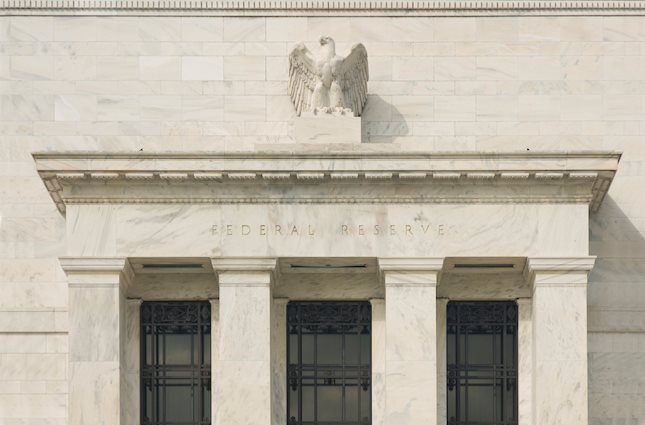- Gold price regains positive traction in reaction to Iran’s attack on Israel over the weekend.
- The upside remains capped amid hawkish Federal Reserve expectations and a bullish USD.
- The US Retail Sales and Empire State Manufacturing Index are eyed for short-term impetus.
Gold price (XAU/USD) struggles to capitalize on its modest gains on Monday and retreats to the lower end of the intraday range during the first half of the European session. The initial market reaction to Iran's attack on Israel over the weekend faded rather quickly, which is evident from a generally positive tone around the equity markets. This, along with expectations that the Federal Reserve (Fed) will delay cutting interest rates, turn out to be key factors acting as a headwind for the safe-haven precious metal.
In fact, market participants have now pushed back their expectations for the first interest rate cut by the Fed to September from June in the wake of still-sticky inflation. This remains supportive of elevated US Treasury bond yields and holds back traders from placing fresh bullish bets around the non-yielding Gold price. Meanwhile, Iran's attack on Israel raises the risk of a broader conflict in the region. This, along with subdued US Dollar (USD) demand, should lend some support to the commodity.
Daily Digest Market Movers: Gold price fails to preserve intraday gains amid hawkish Fed expectations
- Iran's unprecedented direct attack on Israeli territory raised the threat of a wider regional conflict in the Middle East, which, in turn, assists the safe-haven Gold price to regain some positive traction on Monday.
- Israeli officials are in favor of retaliation, though the US clarified that it will not take part in any offensive action against Iran, limiting any immediate market reaction and capping further gains for the XAU/USD.
- Investors pushed back their expectations for the first interest rate cut by the Federal Reserve to September from June following the release of hotter-than-expected US consumer inflation figures last week.
- Moreover, traders are now pricing in the possibility of less than two rate cuts in 2024 as compared to the three projected by the Fed, allowing the US Dollar to stand tall near its highest level since early November.
- The Fed's hawkish outlook, along with the bullish USD, might hold back bulls from placing aggressive bets around the precious metal ahead of the US data – Retail Sales and the Empire State Manufacturing Index.
Technical Analysis: Gold price needs to move back above $2,372-$2,373 area for bulls to regain control
From a technical perspective, the Relative Strength Index (RSI) on the daily chart – despite easing from higher levels – is still holding in the overbought territory. Hence, any subsequent move beyond the Asian session peak, around the $2,371-2,372 area, is more likely to confront stiff resistance and remain capped near the $2,400 mark. The subsequent move up, however, has the potential to lift the Gold price back towards the record peak, around the $2,431-2,432 region touched last Friday.
On the flip side, the $2,334-2,332 horizontal zone is likely to protect the immediate downside, below which the Gold price could extend the corrective fall towards the $2,300 round figure. Some follow-through selling will suggest that the precious metal has topped out in the near term and set the stage for some meaningful depreciating move towards the $2,220 zone with some intermediate support near the $2,250 region.
Gold FAQs
Gold has played a key role in human’s history as it has been widely used as a store of value and medium of exchange. Currently, apart from its shine and usage for jewelry, the precious metal is widely seen as a safe-haven asset, meaning that it is considered a good investment during turbulent times. Gold is also widely seen as a hedge against inflation and against depreciating currencies as it doesn’t rely on any specific issuer or government.
Central banks are the biggest Gold holders. In their aim to support their currencies in turbulent times, central banks tend to diversify their reserves and buy Gold to improve the perceived strength of the economy and the currency. High Gold reserves can be a source of trust for a country’s solvency. Central banks added 1,136 tonnes of Gold worth around $70 billion to their reserves in 2022, according to data from the World Gold Council. This is the highest yearly purchase since records began. Central banks from emerging economies such as China, India and Turkey are quickly increasing their Gold reserves.
Gold has an inverse correlation with the US Dollar and US Treasuries, which are both major reserve and safe-haven assets. When the Dollar depreciates, Gold tends to rise, enabling investors and central banks to diversify their assets in turbulent times. Gold is also inversely correlated with risk assets. A rally in the stock market tends to weaken Gold price, while sell-offs in riskier markets tend to favor the precious metal.
The price can move due to a wide range of factors. Geopolitical instability or fears of a deep recession can quickly make Gold price escalate due to its safe-haven status. As a yield-less asset, Gold tends to rise with lower interest rates, while higher cost of money usually weighs down on the yellow metal. Still, most moves depend on how the US Dollar (USD) behaves as the asset is priced in dollars (XAU/USD). A strong Dollar tends to keep the price of Gold controlled, whereas a weaker Dollar is likely to push Gold prices up.
Information on these pages contains forward-looking statements that involve risks and uncertainties. Markets and instruments profiled on this page are for informational purposes only and should not in any way come across as a recommendation to buy or sell in these assets. You should do your own thorough research before making any investment decisions. FXStreet does not in any way guarantee that this information is free from mistakes, errors, or material misstatements. It also does not guarantee that this information is of a timely nature. Investing in Open Markets involves a great deal of risk, including the loss of all or a portion of your investment, as well as emotional distress. All risks, losses and costs associated with investing, including total loss of principal, are your responsibility. The views and opinions expressed in this article are those of the authors and do not necessarily reflect the official policy or position of FXStreet nor its advertisers. The author will not be held responsible for information that is found at the end of links posted on this page.
If not otherwise explicitly mentioned in the body of the article, at the time of writing, the author has no position in any stock mentioned in this article and no business relationship with any company mentioned. The author has not received compensation for writing this article, other than from FXStreet.
FXStreet and the author do not provide personalized recommendations. The author makes no representations as to the accuracy, completeness, or suitability of this information. FXStreet and the author will not be liable for any errors, omissions or any losses, injuries or damages arising from this information and its display or use. Errors and omissions excepted.
The author and FXStreet are not registered investment advisors and nothing in this article is intended to be investment advice.
Recommended content
Editors’ Picks

AUD/USD trades modestly flat above 0.6400 after Aussie trade data
AUD/USD reacts little to better-than-expected Australian Goods Trade Balance data and remains in a range above 0.6400 early Thursday. Rising bets for an early RBA rate cut cap the Aussie's upside amid China's economic woes and US-Sino trade war fears. Eyes turn to US data, Fedspeak.

USD/JPY fades the dovish BoJ commentary-led uptick above 150.50
USD/JPY is reversing the bounce to near 150.70 in the Asian session on Thursday. The pair remains weighed down by rising bets for another BoJ rate hike this month, shrugging off the dovish comments from BoJ policymaker Nakamura and a modest recovery in the US Treasury bond yields.

Gold price lacks firm near-term direction and is stuck in a familiar range
Gold price extends its sideways consolidative price move in a familiar range, awaiting a fresh catalyst before the next leg of a directional move. Geopolitical tensions, trade war fears and the overnight decline in the US bond yields offer support to the safe-haven XAU/USD.

Ripple's XRP could see a price rebound despite retail activity decline, RLUSD launch delay
XRP traded near $2.4 on Wednesday as Ripple Labs clarified that its RLUSD stablecoin will not debut on exchanges despite a rumored launch among crypto community members. Amid a sharp decline in XRP's price, on-chain data shows the remittance-based token still has the potential to resume its rally.

Four out of G10
In most cases, the G10 central bank stories for December are starting to converge on a single outcome. Here is the state of play: Fed: My interpretation of Waller’s speech this week is that his prior probability for a December cut was around 75% before the data.

Best Forex Brokers with Low Spreads
VERIFIED Low spreads are crucial for reducing trading costs. Explore top Forex brokers offering competitive spreads and high leverage. Compare options for EUR/USD, GBP/USD, USD/JPY, and Gold.